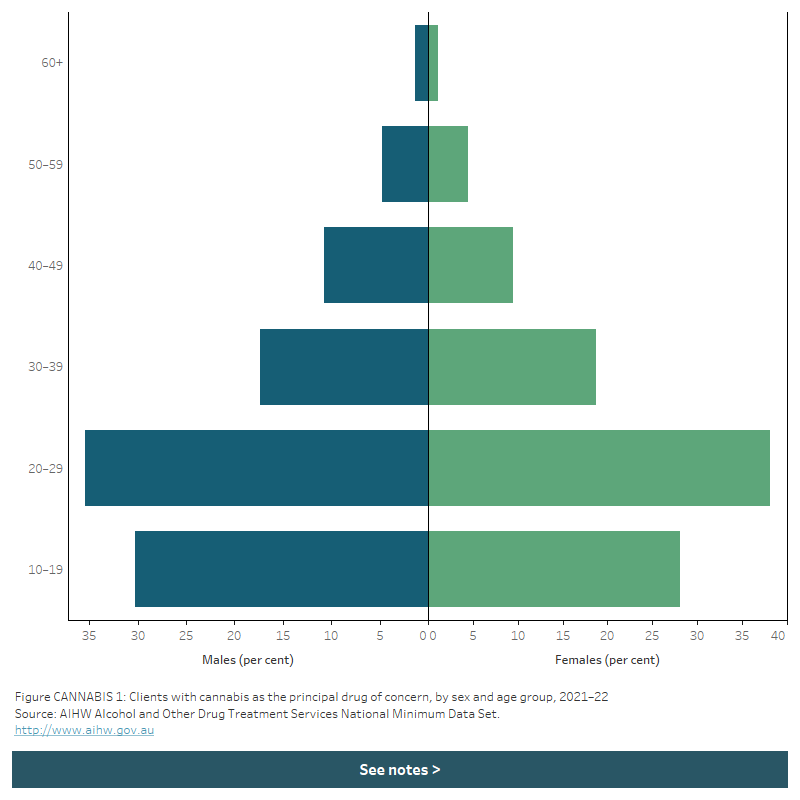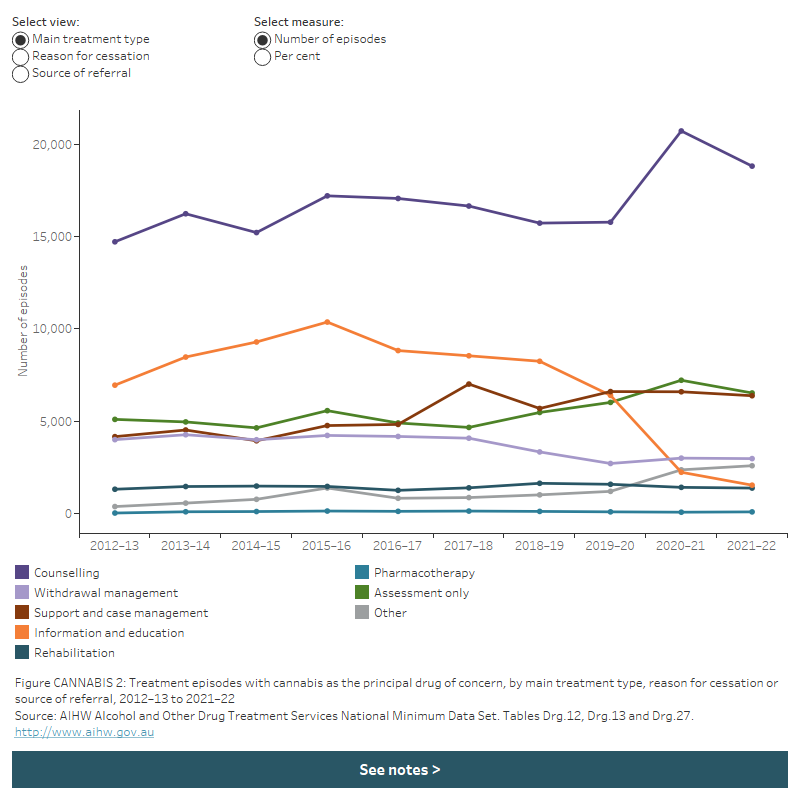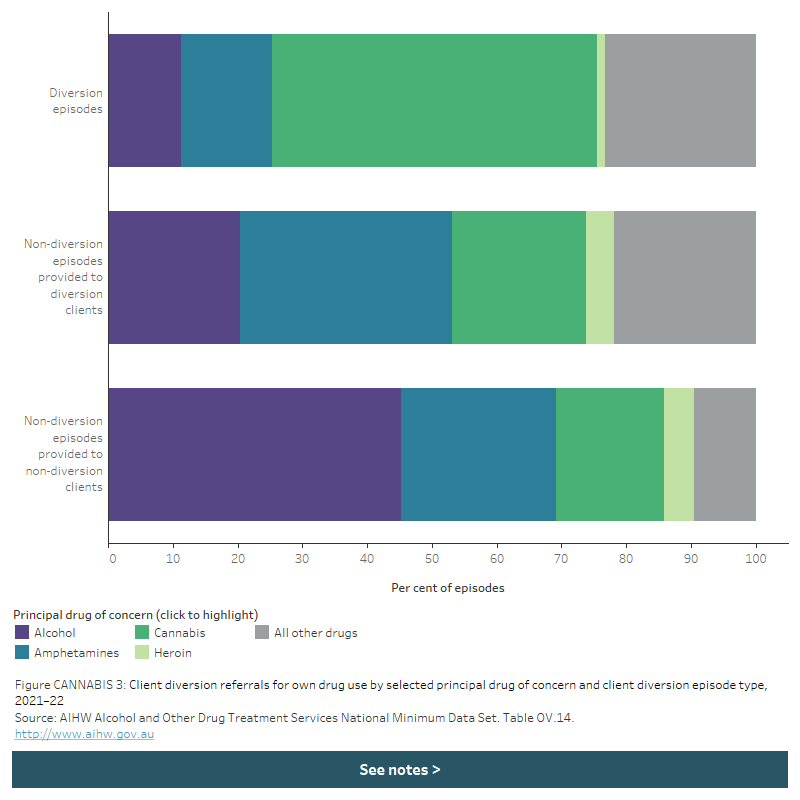Cannabis: client demographics and treatment
In 2021–22, cannabis was reported as a drug of concern (either principal or additional) in nearly 1 in 3 treatment episodes (31% or 64,309 episodes) (Table Drg.4).
Cannabis was the third most common principal drug of concern:
- in nearly 1 in 5 treatment episodes (19% or 40,200 episodes) (Table Drg.4) and this has remained consistent since 2015–16, when cannabis was surpassed by amphetamines as the second most common PDOC
- in the 10 years to 2021–22, treatment episodes for cannabis fluctuated, peaking at 45,000 episodes in 2015–16
- in relation to all other drugs of concern cannabis treatment episodes were most prominent in 2014–15 when they constituted 24% of all episodes (Table Drg.5).
In 2021–22, 3 in 10 cannabis-related treatment episodes had at least 1 additional drug of concern recorded (30% or 12,000 episodes) (Table Drg.2). The most common additional drugs of concern were alcohol (32% or 5,800 episodes), amphetamines (23% or 4,300 episodes) and nicotine (23% or 4,200 episodes) (Table Drg.3). These drugs may not have been the subject of any treatment within the episode.
For information on cannabis use and harms, please see:
- Tobacco, alcohol and other drugs in Australia: Cannabis
- National Drug Strategy Household Survey 2019 (Chapter 4: Illicit use of drugs)
Client demographics
In 2021–22, 25,989 clients received treatment for cannabis as the principal drug of concern. Of these clients:
- over 3 in 5 were male (62% of clients) (Table SC.9)
- around 2 in 3 people were aged either 10–19 (29% of clients) or 20–29 years (37%) (Table SC.10). This was consistent for both males and females (Figure CANNABIS 1)
- around 1 in 5 were Indigenous Australians (20% or 5,300 clients) (Table SC.11). This represents a crude rate of 873 Indigenous clients per 100,000 population (Table SCR.26).
Figure CANNABIS 1: Clients with cannabis as the principal drug of concern, by sex and age group, 2021–22 (per cent)
The butterfly bar chart shows that male clients receiving treatment for cannabis as the principal drug of concern were most likely to be aged 10–19 (30.3% of clients) or 20–29 (35.4%) in 2021–22. This was similar for female clients (28.1% aged 10–19 and 38.1% aged 20–29).

Treatment
In 2021–22, 40,210 treatment episodes were provided to clients for cannabis as the principal drug of concern (Table Drg.4).
Among cannabis-related treatment episodes in 2021–22:
- The most common sources of referral were health services and self/family (both around 29% of episodes), followed by diversion from the criminal justice system (20%) (Figure CANNABIS 32 Table Drg.28). For more information on diversion clients, see Source of referral and diversion clients.
- The most common main treatment type was counselling (47% of episodes), followed by assessment only (16%) (Figure CANNABIS 2, Table Drg.27). Counselling remained the most common main treatment type between 2012–13 and 2021–22.
- 7 in 10 treatment episodes took place in a non-residential treatment facility (70% of episodes) (Table Drg.29).
- The median duration of treatment episodes was just under 4 weeks (26 days) (Table Drg.30).
- Over 3 in 5 episodes ended with a planned completion (62% of episodes), while 21% ended unexpectedly (Figure CANNABIS 2, Table Drg.29).
Figure CANNABIS 2: Treatment episodes with cannabis as the principal drug of concern, by main treatment type, reason for cessation or source of referral, 2012–13 to 2021–22
The line graph shows that counselling was the most common main treatment type among treatment episodes for cannabis across the 10 years to 2021–22, rising from 14,735 episodes in 2012–13 to 18,846 in 2021–22. Assessment only was the second most common main treatment type in 2021–22 (6,523 episodes), though this fluctuated over time. Filters allow the user to view data as the number or per cent of episodes for main treatment type, reason for cessation or source of referral.

Clients referred via diversion programs
Diversion treatment programs
Throughout Australia, diversion programs have been developed to divert people who were apprehended or sentenced for minor drug offences away from the criminal justice system into drug treatment. Treatment services range from short-term assessment, information or education sessions to longer-term treatments such as counselling and withdrawal management. For more information, refer to Diversion programs in Australia data and the Key terminology and glossary.
Most treatment episodes provided to clients diverted from the criminal justice system are for cannabis, followed by amphetamines. Clients who are referred via diversion may also receive other treatment episodes with a source of referral other than diversion.
In 2021–22, around 1 in 8 clients receiving treatment for their own drug use were referred via police or court diversion programs (12% or 14,343 clients) (Table SC.13).
Among these clients:
- around half reported cannabis as the principal drug of concern (49% of clients) (SC.13)
- 23% of these clients also received AOD treatment following referral through other sources, such as from a health service or self/family (Table OV.14)
- 1 in 5 treatment episodes for cannabis as the principal drug of concern were provided to clients who had been referred via diversion programs (20% or 8,200 episodes) (Table Drg.28).
Clients who are referred to AOD treatment via diversion (diversion clients) may receive multiple treatment episodes during a collection period. Some diversion clients may receive treatment with a different source of referral (non-diversion episodes) in addition to the episode where they were referred via diversion (diversion episodes).
In 2021–22, of the 25,144 treatment episodes provided to these clients:
- Cannabis (50%) was the most common principal drug of concern for diversion-related treatment episodes.
- Amphetamines (33%) was the most common principal drug of concern for subsequent non-diversion-related episodes (Figure CANNABIS 4, Table OV.14).
Figure CANNABIS 3: Client diversion referrals for own drug use by selected principal drug of concern and client diversion episode type, 2021–22
The stacked horizontal bar graph shows that cannabis was the most common principal drug of concern (PDOC) among treatment episodes provided to clients referred via diversion in 2021–22 (50.1% of episodes). By comparison, amphetamines was the most common PDOC among non-diversion episodes provided to diversion clients (32.8% of episodes) and alcohol was the most common PDOC among non-diversion episodes provided to non-diversion clients (45.3%).



